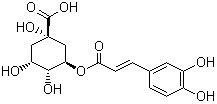V. No hypersusceptibility
VI.100% natural
g)Chlorogenic acid and caffeic acid are antioxidants in vitro and might therefore contribute to
the prevention of Type 2 Diabetes Mellitus and cardiovascular disease. h)Chlorogenic acid has
been proven in animal studies in vitro to inhibit the hydrolysis of the glucose-6-phosphate
enzyme in an irreversible fashion.The studies also confirmed a reduction in blood glucose
evels and an increase in the intrahepatic concentrations of glucose-6-phosphate and of glycogen.
Description of chlorogenic acid:
a) Has a wide range of biological effects, from insect resistance to human health
b) An important factor in plant metabolism
c) An antioxidant and has anti-fungi effectivity,stronger than the antibacterial
effectivity
d) An ester of caffeic acid and quinic acid, a major phenolic compound in coffee,
the daily intake of coffee drinkers is 0.05-0.1g
e)Strong antioxidants in vitro and could therefore be contribute to the prevention of disease
caused by free radicals Chlorogenic acid, an ester of caffeic acid and quinic acid, is a major
phenolic compound in coffee, but is also found widespread in plants and can be isolated from the
leaves and fruit . This compound, long known as an antioxidant, also slows the release of glucose
into the bloodstream after a meal.
f) Structurally, chlorogenic acid (CGA) is the ester formed between caffeic acid and (L)-quinic
aicd(1L-1(OH),3,4/5-tetrahydroxycyclohexanecarboxylic acid). Isomerisation of the quinic acid
in position 3, (3-CQA),4 (4-CQA) and 5 (5-CQA). Isomerisation at position 1 has not yet been
reported. Isomers of chlorogenic acid are found in potatoes. They are 4-O-caffeoylquinic acid
(crypto-chlorogenic acid), 5-O-caffeoylquinic acid (neo-chlorogenic acid), 3,4-dicaffeoylquinic
acid and 3,5-dicaffeoylquinic acid.







 Chlorogenic Acid
Chlorogenic Acid 
